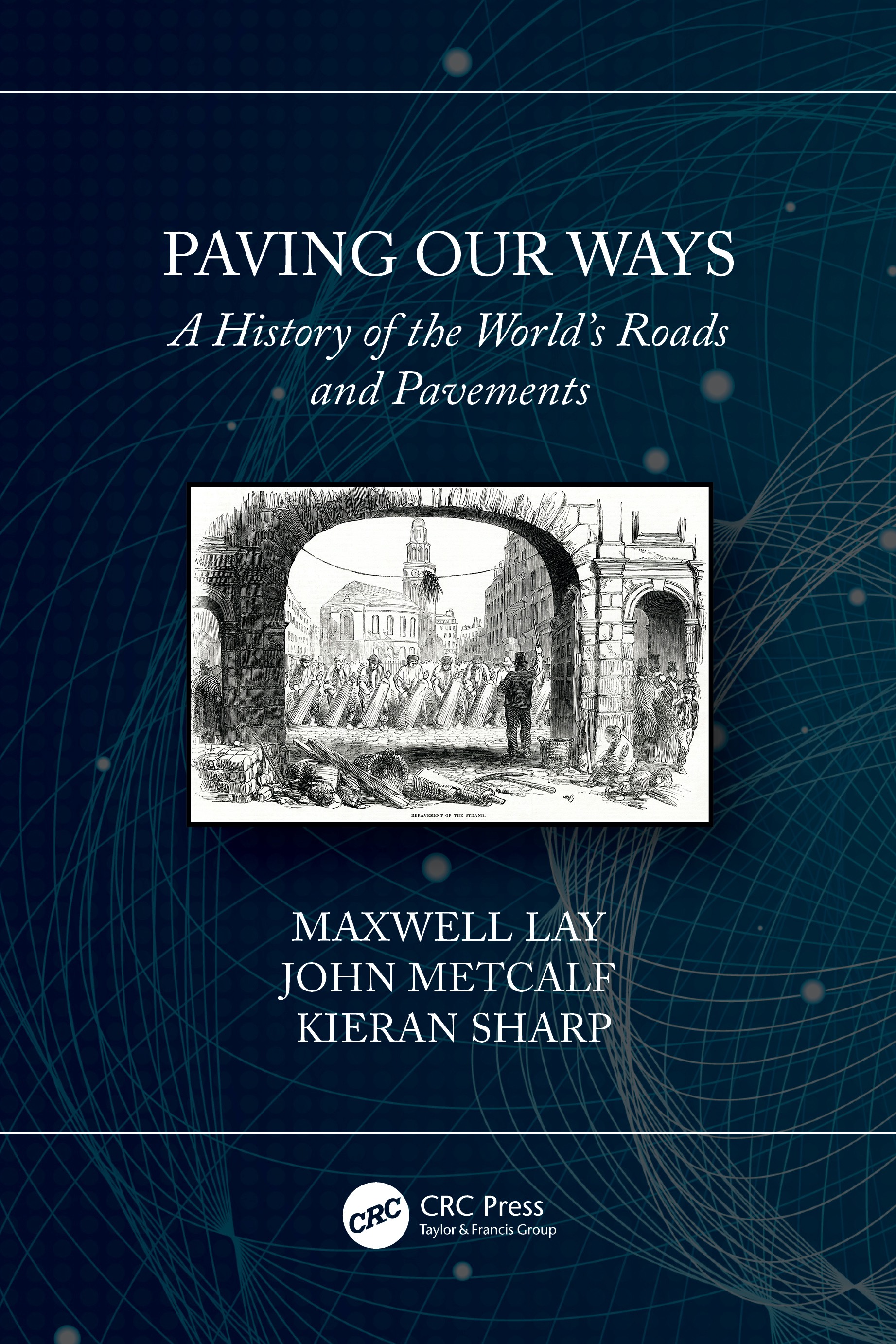Maxwell Lay, Ph.D., P.E., M.ASCE, lead author of Paving Our Ways: A History of the World’s Roads and Pavements (CRC Press, 2020), talks with Civil Engineering about how roads have evolved over the millennia, the milestone moments that have made modern roads possible, and his thoughts on how changing demands for fossil-fuel-based vehicles might impact road construction in the future.
Civil Engineering: Could I get a quick elevator pitch of the book and its findings?
ML: The book is an attempt to give an international picture on the development of road pavement since the beginning of time to the current day, and then predict the future a bit. We took an international view because we’ve worked in most of the countries of the world and we found that most of what other people had written on the topic was fairly localized. We thought that pavements give an interesting view of society as a whole, so the book emphasizes not just the technology but why it happened and who did it and the politics of it. Even back in the past you can see that over time, the patterns in the history of how pavements were developed are not dissimilar.
What did the earliest manufactured roads look like when it came to form, function, and materials?
The first manufactured road to exist was part of the manufacture of one of the pyramids in Egypt. They had to bring in limestone blocks of about a meter to 2 meters in size from about a hundred kilometers away from the pyramid. And they did it by making a road from the quarry to the Nile and floating the blocks down. And they built another road from the wharf to the pyramids. And that road still exists as the oldest road we have in existence, from about 2,500 B.C. The limestone blocks required a lot of work to move; they probably rolled them on logs.
After that, there were roads built in Mesopotamia in the Fertile Crescent, places like Babylon and Baghdad. And those roads were mainly built for processional reasons, to serve the temples and make the emperor more impressive, rather than for day-to-day use as a pavement. And some of those still exist. A few of them were destroyed in the recent crises in that area, but several of them still exist. And Nebuchadnezzar, whose name is often quoted in the Bible, he is quoted as saying his father built one of the roads that would exist forever.
We have seen that over a long historical period, from 1100 B.C., where they mortared together these big blocks of limestone or bricks made from sand and straw or clay. And in that area there was, and still is, petroleum. So there is also bitumen, the heavy byproduct of petroleum. The bitumen seeped from underground, and they heated the bitumen to use as a mortar to create a coherent surface.
What’s the biggest difference, would you say, between those early roads and our modern roads?
Modern roads also have a coherent surface. Everything is together in a single surface, whereas between the early Mesopotamian roads and now, most of the roads were cobblestones or loose stones, which were very easily disturbed. But for the last hundred years or so we’ve been producing coherent surfaces on the roads.
Why do you think there was that huge period of time where there weren’t coherent roads?
It was very expensive to make block roads. The Romans made coherent roads similar to horizontal walls, but they had lots of masons and slaves who could do it. Otherwise, it was too expensive. A road had to be fairly cheap and use local materials, such as boulders and pebbles from the riverbeds.
What does the evolution process to modern roads look like? And what were the most important elements that got us as a globe and as an industry from there to here?
When the Industrial Revolution began, all of the sudden in Europe in particular and to a lesser extent in America, roads were needed to transport goods and materials. So that’s when people started being serious about road making. And people — a Frenchman called Pierre-Marie-Jérôme Trésaguet and two Scotsmen called John Loudon McAdam and Thomas Telford — developed relatively modern road making methods involving drainage and the use of stone masons.
It wasn’t until steam engines were invented that we began to be able to crush stone into broken stone that is compacted together to form a pavement. But even then, there was big controversy because the tradition was to use river pebbles, but McAdam said in about 1810 that broken stones make better roads. It took about 100 years before everyone believed that what McAdam said was true. And his name was used to describe the type of road — a macadam road. And when they put the pebbles together with tar it was called tar macadam, which became ‘tarmac,’ a term still used in some places.
And then in the middle of the 20th century, oil refining started, and a byproduct of oil — a waste product really — is bitumen, also known as asphaltic cement. When that became readily available, it became possible to make roads economically. Of course, you can also make roads out of concrete. Concrete roads and asphalt roads are competitive, but by and large asphalt roads are cheaper than concrete roads.
What was the American contribution to the development of modern road making?
America industrialized road making in a way that no one had done before. One of the big American contributions was to produce the machinery that allowed stones to be crushed and asphalt to be mixed and placed.
This industrialization of road making happened in America after the steam engine was developed, which led to the German development of internal combustion engines. After that, in America, Henry Ford got into the act. People started making trucks powered by internal combustion, and initially those trucks were not used too frequently. But in the First World War, the trucks started to be a major facility and part of the war, and America supplied the trucks to the Allies even before America entered the First World War. And those trucks had to be taken from the factories to the seaboard ports. The result was that all the prewar roads from factory to port were quickly destroyed and had to be rebuilt.
The other big American contribution was in the 1930s, when the California Division of Highways (a forerunner to the California Department of Transportation) developed a method called the California Bearing Ratio, CBR, to decide how thick pavements should be. A very simple method based on tests they’d done. And it was so effective that people still use it all around the world. And its use had a big boost in the Second World War, when it was used by the U.S. Army Corps of Engineers to design airfields in the Pacific.
The CBR is determined with a stamping machine that you just press into the site where you are going to put a road to see how far into the exposed soil it goes. And that’s a measure of the bearing strength of the road, which determines how thick the pavement should be. And in a primitive way it works exceedingly well. You just need this machine.
It’s still used around the world for making simple roads. You wouldn’t use it for a freeway, but for an ordinary conventional country road or city street, you’d use it.
What countries saw the growth of roads the fastest? Was it really densely populated countries like you see in Europe? Or was it in the U.S., where you have lots of space?
First, it was density because you have to have a market to pay for the roads. In low-density areas it’s harder to get the funds for the roadways. As the tracks opened up in the west in America, they were very primitive by modern standards. It wasn’t until the 1930s and later that they were upgraded. In fact, a big problem in much of America at that time was the enormous problems with dust produced from those surface roads. If you looked in American magazines in the 1930s, you’d find dust prevention was one of the great issues at the time. There were complaints from local communities, farmers, and small towns, and there were a number of proprietary products marketed to put the dust down — but they only lasted until the next rainstorm.
What was the biggest surprise or the most significant finding that you came across in your research and writing?

I think the biggest issue we found was how people didn’t think about how they had to maintain their roads after they were built. It was a message that was very slowly learnt. And then there is the economic issue — the engineering is simple compared to the economics of how you are going to fund the construction and maintenance of a road. And that’s a problem all around the world. Some communities are very good at it, and others are very bad at it.
What was the biggest takeaway you wanted to leave your readers with?
The biggest takeaway is that there is more to roads than just their surface. There is quite a complex technology underneath. And in a technical sense, the engineering is difficult because the materials are quite primitive and we must depend on local materials. And, unlike building a bridge, we can’t predict the elasticity or the slant very accurately, so there’s a lot more intuition rather than science in it.
And roads just don’t last very long at all. Roads need to be maintained almost annually and need to be remade almost every 10 years. They start wearing out from the first truck that goes over them.
What does the future of roads look like? The biggest challenges, the biggest opportunities?
The opportunities have to be in the tax and the economics of managing the road. We can now make the roads well, but some of the materials we use are energy intensive. We have to learn how to recycle the road better, although America is already very good at that. Someone said that American roads are America’s biggest quarry these days because once you dig up a road you can recycle it — break up the bits and reuse them. For the most part, we don’t need more length of road or width of road. It’s really managing the roads we’ve got, which is going to be very important through recycling.
In your opinion, where do we as a globe, as an industry, and as an engineering profession go from here?
I think for the future, the road technology is fairly OK. However, although recyling will help, we still lack an alternatives to bitumen, asphalt, and cementitious concrete for use in road construction. Bitumen relies on petroleum, so its availability depends on the reliance on fuel supplies for vehicles. Because bitumen is a byproduct of oil, refining it may become scarcer, more expensive, and less acceptable environmentally in the future.




